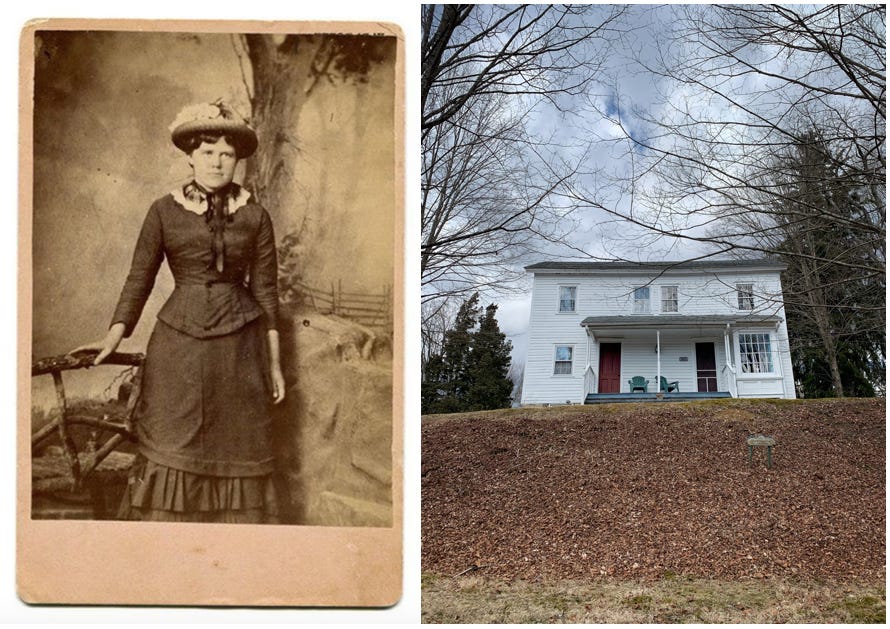Sunday Pastries With the Dead 19
The story of a sensationalized 1886 New Jersey murder, and both its victims.
In the early morning hours of April 9, 1886, the body of a 17-year-old woman was discovered by a man walking his dog through the field behind a small central New Jersey college. She’d been raped and strangled; hand-shaped bruises blossomed at her throat, and a wound on her forehead indicated that she’d been struck. The man who eventually went to prison for her murder is popularly believed to have been innocent. The victim and accused perpetrator are buried within sight of each other at the same New Jersey cemetery, just two miles down the road from where the murder took place. This is their story.

Matilda “Tillie” Smith was born on June 20, 1868; she grew up in the village explored in SPWTD 18 (her grandfather John—and eventually her father Nathan—owned the land upon which it was built).
In January 1886, Tillie began working in a local college’s basement kitchen as a potato peeler and domestic servant; she also boarded in the women’s section of the same building. She had just learned to read and, by all evidence, was thrilled to take on this job as a step up in life. This is what the college looked like at the time Tillie lived and worked there—it burned down in 1899, and many attributed the disaster to her ghost, who is still seen roaming the campus. The rebuilt structure pictured above was completed in 1901.

The story that eventually stuck is that the day Tillie died, she asked the college’s maintenance worker, 29-year-old James Titus, to let her in after the 10:00 p.m. curfew so she could attend a late-night theater show with friends. When she returned that night, he raped and choked her to death and put her body in the field behind the building.

An alternate story persists that Tillie asked Titus to let her in and he refused, so she instead came home late to find the building doors locked and headed to a nearby stable to spend the night—this is when she was intercepted by her attacker. Further supporting that theory: there was evidence that Tillie put up a struggle, yet not one witness heard her scream. The ground around her body hadn’t been disturbed, but her clothing was amiss and her dress was covered in dust, pointing to her murder locale as an off-site barn or shed.
A psychic medium recently channeled Tillie and named her ex-boyfriend Frank Weeder as the culprit, saying he and a friend who were seen in the vicinity of the theater performance she attended that night killed her in a crime of passion. Weeder purportedly committed suicide two months after Tillie’s death.
Police sloppily let two other suspects go free on account of a loose alibi that they’d been drinking at a local taphouse during the assumed time of the murder. They were a pair of traveling salesmen Tillie met with her girlfriends while at the theater show—Tillie and her friend Annie stayed with the salesmen after the performance, and one even offered to pay for Tillie’s room if she’d join him at a local boarding house. She declined and left the group to head home—it was the last time she was ever seen alive.
The doctor who performed Tillie’s autopsy said she’d been violated by more than one man, and there were no drag marks on the body, signifying that she’d been carried to the field postmortem by two people.
Public outcry demanded someone pay for the heinous crime. Titus was the only person police had sufficient, albeit flimsy, evidence collected against, so he was tried at the courthouse pictured in SPWTD 12. Major newspapers across the country ran coverage, and Titus’ trial was hugely sensationalized. He—described as a small, quiet man who kept to himself and was prone to panic attacks—maintained his innocence, and most of the evidence against him was circumstantial. Nevertheless, Titus was convicted after a month-long hearing, and sentenced to hang.
Titus escaped the death penalty only by signing a confession of guilt, in which he said he and Tillie had an affair after she seduced him, and he accidentally killed her during a quarrel when she claimed to be pregnant and threatened to out their relationship. He served 19 years of hard labor in Trenton State Prison and never saw his wife Nettie again; she died in November 1904, just one month before his December 27 release.
Titus lived for almost fifty more years in the very town that had turned against him, a cloud of gossip and censure hanging over his and his family’s heads. He’s buried just down the slope from Tillie, alongside his wife and parents. To this day, locals are fighting to obtain a posthumous pardon for Titus.

Tillie’s stunning burial monument is situated on its own atop the highest point in the cemetery; it was funded by local and national benefactors, and bears a statement that books and plays about Tillie have been titled after: “She died in defence of her honor.” Tales of her ghostly hauntings here and at the college grounds still persist; visitors pay their respects by leaving grave goods like coins, jewelry, and glass statues on her headstone.
While the statement on Tillie’s gravestone is now greatly dated, reflecting the antiquated notions of purity at the time, it bears noting: virginity is a construct, and honor is not tied to sexual activity (consensual or not). The implication that Tillie somehow lost her honor alongside her life is victim-blaming garbage. She had nothing to defend but her own existence, which was snuffed out by one or more people in a shocking act of violence.
We see you, Tillie. Until next Sunday, fellow taphophiles!





